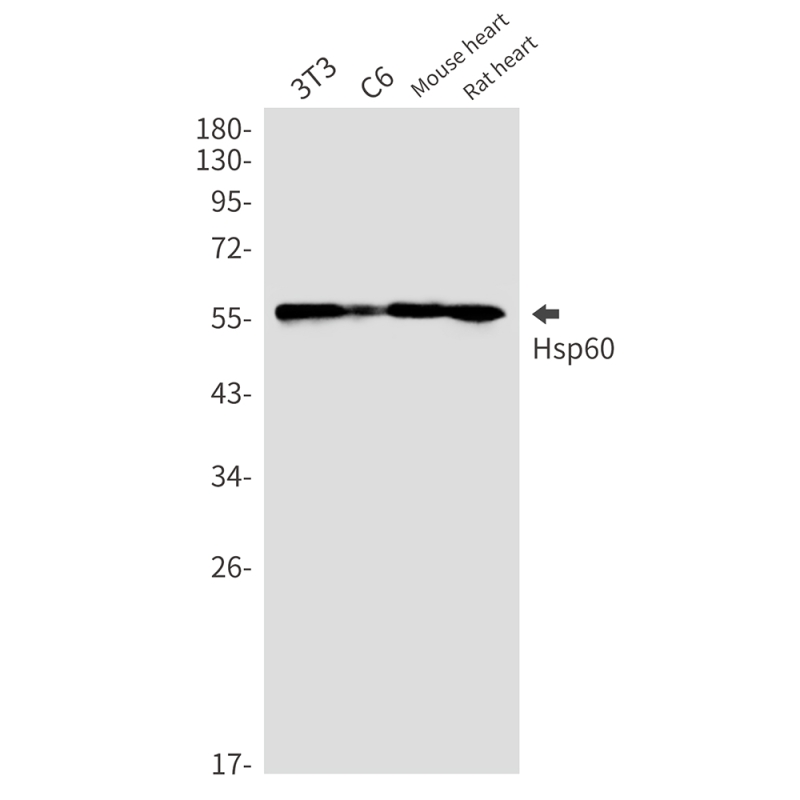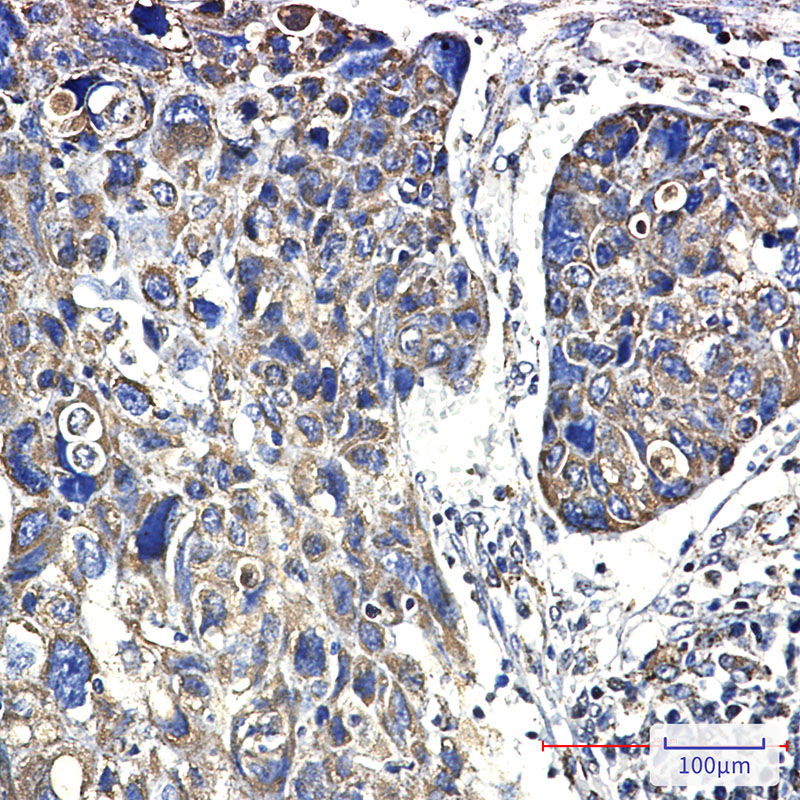


| WB | 1/500-1/1000 | Human,Mouse,Rat |
| IF | 咨询技术 | Human,Mouse,Rat |
| IHC | 1/50-1/100 | Human,Mouse,Rat |
| ICC | 技术咨询 | Human,Mouse,Rat |
| FCM | 咨询技术 | Human,Mouse,Rat |
| Elisa | 咨询技术 | Human,Mouse,Rat |
| Aliases | HSPD1; HSP60; 60 kDa heat shock protein; mitochondrial; 60 kDa chaperonin; Chaperonin 60; CPN60; Heat shock protein 60; HSP-60; Hsp60; HuCHA60; Mitochondrial matrix protein P1; P60 lymphocyte protein |
| Entrez GeneID | 3329 |
| WB Predicted band size | Calculated MW: 61 kDa; Observed MW: 61 kDa |
| Host/Isotype | Rabbit IgG |
| Antibody Type | Primary antibody |
| Storage | Store at 4°C short term. Aliquot and store at -20°C long term. Avoid freeze/thaw cycles. |
| Species Reactivity | Human,Mouse,Rat |
| Immunogen | A synthetic peptide of human Hsp60 |
| Formulation | Purified antibody in TBS with 0.05% sodium azide,0.05%BSA and 50% glycerol. |
+ +
以下是3篇关于Hsp60抗体的代表性文献摘要(信息基于公开研究整理):
---
1. **文献名称**: *Heat shock protein 60 antibodies in atherosclerosis*
**作者**: Xu Q, et al.
**摘要**: 该研究发现Hsp60抗体与动脉粥样硬化患者血管炎症密切相关,提示Hsp60可能通过激活免疫反应促进斑块形成,其抗体水平可作为心血管疾病风险的潜在生物标志物。
2. **文献名称**: *Anti-Hsp60 antibodies in Chlamydia trachomatis infection*
**作者**: Cappello F, et al.
**摘要**: 研究揭示衣原体感染会诱导机体产生针对Hsp60的交叉抗体,导致慢性炎症和自身免疫损伤,解释了部分生殖系统感染后并发症的免疫机制。
3. **文献名称**: *Hsp60 as a target in rheumatoid arthritis*
**作者**: Zanin-Zhorov A, et al.
**摘要**: 实验证明类风湿关节炎患者体内Hsp60抗体水平升高,且与疾病活动度正相关,提示靶向Hsp60或其抗体的治疗策略可能缓解自身免疫反应。
---
**提示**:如需具体文献全文,建议通过PubMed或ResearchGate输入标题查询DOI链接。实际引用时请注意核对作者、期刊和发表日期等细节。
**Background of Hsp60 Antibodies**
Heat shock protein 60 (Hsp60), a member of the chaperonin family, is a highly conserved protein present in both prokaryotic and eukaryotic organisms. It primarily facilitates protein folding and assembly within mitochondria, ensuring proper conformation of newly synthesized polypeptides. Under stress conditions—such as heat, infection, or inflammation—Hsp60 expression increases to mitigate cellular damage and maintain proteostasis.
Hsp60 antibodies are autoantibodies targeting this chaperonin. Their production is often linked to molecular mimicry, where immune responses against microbial Hsp60 (e.g., from *Chlamydia* or *E. coli*) cross-react with human Hsp60 due to structural similarities. This phenomenon is implicated in autoimmune diseases like rheumatoid arthritis, systemic lupus erythematosus, and type 1 diabetes. Additionally, Hsp60 antibodies are associated with atherosclerosis, as stressed endothelial cells express surface Hsp60. triggering immune-mediated vascular inflammation.
In clinical contexts, elevated Hsp60 antibody levels are studied as potential biomarkers for chronic inflammatory conditions and autoimmune disorders. However, their role remains complex; while they may contribute to pathology, Hsp60 antibodies can also exhibit regulatory functions, modulating immune responses depending on context. Research continues to explore their diagnostic and therapeutic relevance, though challenges persist in distinguishing pathogenic from protective antibody subsets and understanding their disease-specific mechanisms.
(Word count: 200)
×